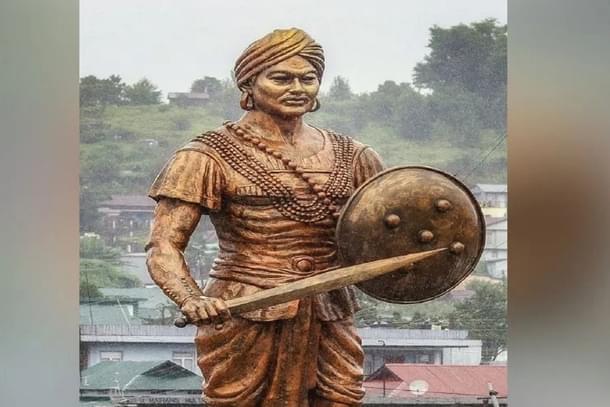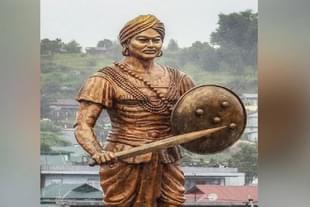Heritage
Statue Of Khasi Freedom Fighter To Be Installed At Indian Cultural Centre In Dhaka
Swarajya Staff
Aug 02, 2023, 03:50 PM | Updated Dec 05, 2023, 02:09 PM IST
Save & read from anywhere!
Bookmark stories for easy access on any device or the Swarajya app.


Prime Minister Narendra Modi's government has decided to install a statue of a celebrated Khasi freedom fighter U Tirot Singh, at the Indian Council for Cultural Relations (ICCR) complex at Dhaka in Bangladesh.
This move comes in keeping with the centre's resolve to honour & celebrate the lives of freedom fighters who have been neglected by the Nehru-Gandhi dynasty for so many decades.
U Tirot Singh, who rebelled against the British some 200 years ago and led a four-year-long guerilla war against British forces from April 1829, was captured by the British in January 1833. He was deported to Dhaka where he died on 17 July, 1835.
Though Meghalaya commemorates 17 July every year as U Tirot Singh Day, little is known of the valiant Khasi chieftain outside the state.
The ruling Meghalaya Democratic Alliance (MDA) government in the Northeastern state — the BJP is a partner in the alliance — had sent a proposal to the Ministry of External Affairs (MEA) last year to install a statue of the Khasi freedom fighter in Dhaka.
Meghalaya’s Art and Culture Minister Paul Lyngdoh said that the MEA readily agreed to the proposal.
“We have now received communication from the MEA that a statue of U Tirot Singh will be installed at the library of the ICCR at Dhaka. Not only that, the library will also be named after him,” said Lyngdoh.
India’s high commissioner to Bangladesh, Pranay Verma, told Swarajya over phone from Dhaka that the installation of a life-size statue of the valiant Khasi freedom fighter would enhance the ongoing Azadi ki Amrit Mahotsav celebrations by the Indian mission in Bangladesh.
Verma confirmed that the library at the ICCR complex at Dhanmondi in Dhaka, would also be renamed after U Tirot Singh and a bust or portrait of the freedom fighter who spent his last years in Dhaka would be displayed at the library.
President of the BJP’s Meghalaya state unit Ernest Mawrie said that the decision to install a statue of U Tirot Singh at the Indian cultural centre in Dhaka was a “momentous one” and would endear the Narendra Modi government to the people of Manipur.
“Little is known of U Tirot Singh outside Meghalaya. He has remained an unsung hero for the rest of the country. But now, everyone will get to know of him,” said Mawrie.
U Tirot Singh’s life and fight against the British will also find pride of place in history textbooks in the rest of the country, said Mawrie.
“The people of Meghalaya shall remain grateful to Prime Minister Modi for this,” Mawrie added.
The union government is also planning a series of events to highlight the lives and struggles of many freedom fighters from all parts of the country who have remained uncelebrated for so long.
U Tirot Singh, born in Mairang (present day headquarters of Eastern West Khasi Hills district of Meghalaya in 1802, was the Syiem (chief) of Nongkhlaw, a small group of villages.
He had agreed to allow the British to construct a road through his territory to connect Guwahati with Sylhet (in present-day Bangladesh) in return for British help to regain part of his principality, that had been captured by a rival chieftain.
The British reneged on their promise and Tirot Singh asked the British to vacate Nongkhlaw where they were camping for constructing the Guwahati-Sylhet road. The British refused to pay heed and on 4 April 1829, Tirot Singh led his forces to attack the small British garrison at Nongkhlaw.
Two British officers — Richard Gurdon Bedingfield and Philip Bowles Burlton — were killed. This infuriated the British who launched a manhunt for Tirot Singh and some other Khasi chieftains who had participated in the attack.
But the Khasi forces, armed only with bows and arrows and other traditional weapons, were no match for the British forces equipped with muskets and other firearms. The Khasi forces under Tirot Singh launched a guerrilla war, ambushing and attacking British forces.
The guerilla war continued for nearly four years before the British shot and wounded Tirot Singh in December 1832. He took refuge in a cave, but his location was given away by another Khasi chieftain who was bribed by the British with gold coins.
The British forces captured Tirot Singh in January 1833 and took him away to Dhaka to imprison him there. Tirot Singh died in captivity on 17 July 1835.
Minister Paul Lyngdoh said that the state government is coordinating with the union government to make the statue of U Tirot Singh.
The statue will most probably be ready for installation by next year. Its unveiling is expected to be a grand affair, Lyngdoh added.





